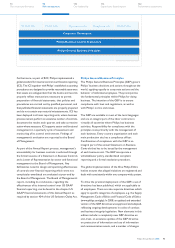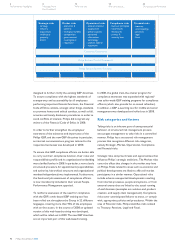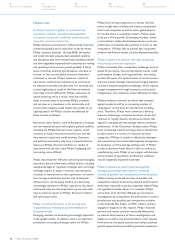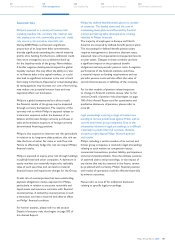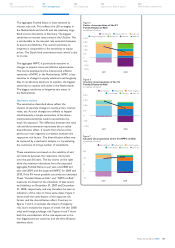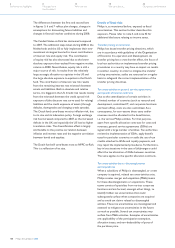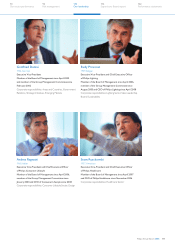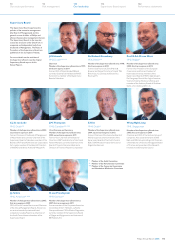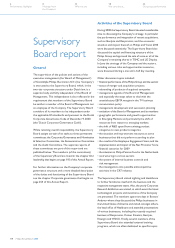Philips 2008 Annual Report Download - page 105
Download and view the complete annual report
Please find page 105 of the 2008 Philips annual report below. You can navigate through the pages in the report by either clicking on the pages listed below, or by using the keyword search tool below to find specific information within the annual report.
Credit risk with number of counterparties
25-100
million
100-500
million
500-2,000
million
AAA-rated governments −11
AAA-rated government banks
−11
AAA-rated bank
counterparties −−1
AA-rated bank
counterparties 1−−
A-rated bank counterparties 31−
Other insurable risks
Philips is covered for a range of different kinds of
losses by global insurance policies in the areas of
property damage, business interruption, general and
product liability, transport, directors’ and officers’
liability, employment practice liability, fraud, and
aviation product liability.
To lower exposures and to avoid potential losses,
Philips has a worldwide Risk Engineering program in
place. The main focus in this program is on property
damage and business interruption risks, which also
include interdependencies. Philips sites, and also
a limited number of sites of key suppliers, are inspected
on a regular basis by the Risk Engineering personnel
of the insurer. Inspections are carried out against
predefined Risk Engineering standards which are agreed
between Philips and the insurers. Recommendations
are made in a Risk Management report and are
reviewed centrally. This is the basis for decision-
making by the local management of the business as to
which recommendations will be implemented. For all
policies, deductibles are in place, which vary from
EUR 250,000 to EUR 500,000 per occurrence and
this variance is designed to differentiate between
the existing risk categories within Philips. Above this
first layer of working deductibles, Philips operates its
own re-insurance captive, which during 2008 retained
EUR 2.5 million per occurrence for the property
damage and business interruption losses and EUR 5
million in the aggregate per year. For general and
product liability claims, the captive retained EUR 1.5
million per claim and EUR 6 million in the aggregate.
New contracts were signed on December 31, 2008
for the coming year, whereby the reinsurance captive
retentions remained unchanged.
The company does not enter into any financial
derivative instruments to protect against default by
financial counterparties. However, where possible
the company requires all financial counterparties
with whom it deals in derivative transactions to
complete legally enforceable netting agreements
under an International Swap Dealers Association
master agreement or otherwise prior to trading,
and whenever possible, to have a strong credit rating
from Standard & Poor’s and Moody’s Investor Services.
Philips also regularly monitors the development of
credit default swap prices of its financial counterparties.
Wherever possible, cash is invested and financial
transactions are concluded with financial institutions
with strong credit ratings or with governments or
government-backed institutions.
Country risk
Philips is exposed to country risk by the very nature
of running a global business. Country risk is the risk
that political, legal, or economic developments in a
single country could adversely impact our performance.
The country risk per country is defined as the sum of
the equity of all subsidiaries and associated companies
in country cross-border transactions, such as
intercompany loans, accounts receivable from third
parties and intercompany accounts receivable. The
country risk is monitored on a regular basis.
As of December 31, 2008, the company had country
risk exposure in the Netherlands of EUR 9 billion and
in the United States of EUR 10 billion. Other countries
exceeding EUR 1 billion but less than EUR 5 billion
included Belgium and China (including Hong Kong).
Countries where the risk exceeded EUR 200 million
but was less than EUR 1 billion included Germany,
Korea, United Kingdom, Russia, Poland, France,
Canada, Austria, Japan, Taiwan and Italy . The degree
of risk of a country is taken into account when new
investments are considered. The company does not,
however, use financial derivative instruments to hedge
country risk.
Philips Annual Report 2008 105
122
Performance statements
114
Supervisory Board report
110
Our leadership
94
Risk management
70
Our sector performance


